Carnival of Souls, 1962, directed by Herk Harvey, written by John Clifford.
I write a lot about comedy as though it were the great neglected genre. And it's true; comedies don't get a lot of critical acclaim. But nobody gets less respect than horror movies. Except for B-horror movies from the sixties. And the only films that get less respect than B-horror movies are B-horror movies made in Lawrence, Kansas, by filmmakers who never worked on another feature. So what is Carnival of Souls doing in the Criterion Collection? I'd love to report that it's a brilliant film, a lost gem of incalculable worth. Well, it's not. But it's not quite a B-picture, either. The filmmakers got a lot wrong; the sound is laughably badly mixed, there are some terrible performances (and some passable ones), and a great deal of the movie, particularly toward the end, just isn't very frightening. But in the weeks after you see it, you will find yourself remembering some of the strangeness of the film, its odd tone, its uncanny images.
And even if you don't, you'll remember the movie because of its strange pedigree. Variety's review began, "Occasionally a feature film emerges from the midwest..." John Clifford and Herk Harvey were both employees of Centron Studios, one of the big three producers of educational and industrial movies (the other two were Coronet and Encyclopædia Britannica). And like any good social guidance film, it opens with young people making a terrible decision. In this case, they agree to drag race, which ends pretty much how you would expect.
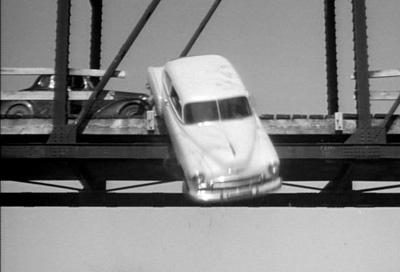
If the movie had been directed by Sid Davis, that would have been the last shot. If it had been a Highway Safety Foundation production, that wouldn't have been the last shot, but audiences would have wished it was. In Centron movies, though, things always tended to be a little murkier. And speaking of murky, the car crash isn't as tragic as it looks, at least for one of the passengers.
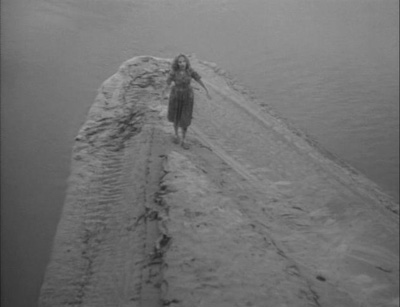
That's Candace Hilligoss playing the sole survivor, Mary Henry. She remembers next to nothing about the wreck, but we see her haunting the bridge soon after, staring into the water. We don't see anything of her life in Kansas, where the movie begins, except for a brief scene of her practicing organ on the assembly floor of the Reuter's Organ Company:
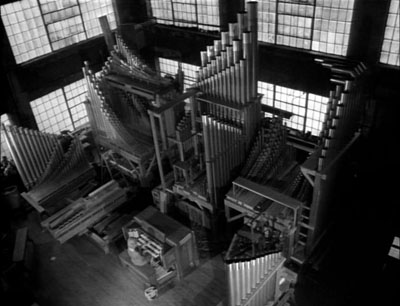
She's not always shot from such a distance, but she is consistently apart from everyone else in the movie. Apparently on the theory that a change of scenery will do her good, she leaves town as soon as she can, to take a job as a church organist in Salt Lake City. Asked to "stop by and see us the next time you're in," she replies, "Thank you. But I'm never coming back." She's as good as her word.
On the drive west, her radio goes on the fritz: whatever channel she turns it to, all it picks up is organ music in minor keys. In the distance, she sees a hulking building across the salt flats:
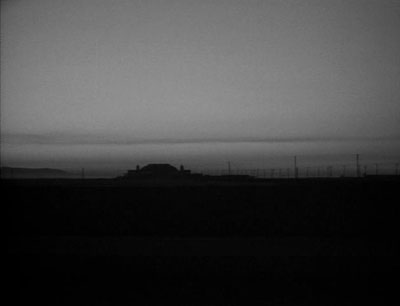
And almost immediately she runs off the road to avoid hitting a gaunt apparition who looks suspiciously like the director wearing grease paint:
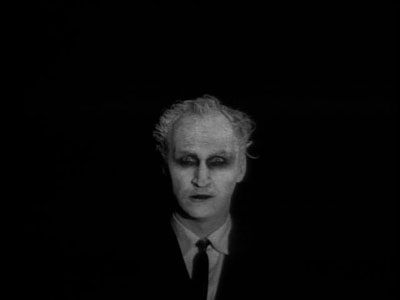
And there her troubles begin. For the rest of the movie, Hilligoss keeps seeing this guy, and finds herself strangely fascinated by the strange building she passed on the highway. That building is the movie's secret weapon, and I believe it is the reason it has survived so long. On his way back from a vacation in Los Angeles, Herk Harvey passed the same hulk of a building off the freeway, and was curious enough to pull off and check it out. What he found was the wreckage of a grand experiment in Mormon entertainment, created while the church was distancing itself from its first grand experiment in Mormon entertainment, "celestial marriage."
In 1893, the Church of Latter Day Saints built a resort on the edge of the Great Salt Lake to provide wholesome entertainment for young families called Saltair. It featured salt water bathing in the lake and a grand pavilion on piers over the water, and was remarkably successful:
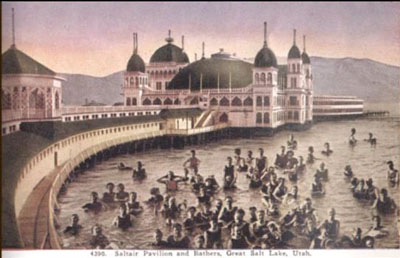
Believe it or not, you're looking at one of the most famous tourist attractions of its time. In 1925 the whole thing burned to the ground and was rebuilt on a slightly less grand scale:
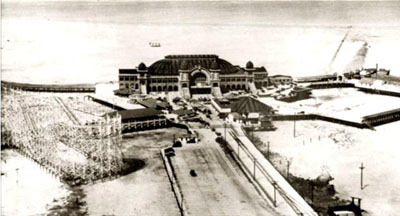
Notice that the large central tower is missing, as is the second level of the promenade. You can also see the park's roller coaster and the railway tracks leading in near the road. The centerpiece of Saltair's second incarnation was the enormous dance pavilion. I believe this photo is of the second dance pavilion, at its time one of the largest in the world:
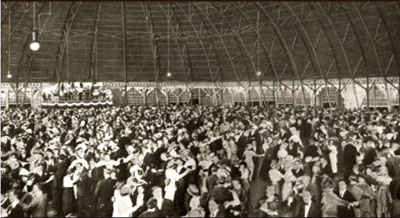
In the late 30s, the salt lake receded away from the pavilion, leaving it on a great muddy plain, which proved to be somewhat less appealing to vacationers. Still, they limped along until 1958; so when Harvey shot there, it had been closed for about three years. Here's what he found:
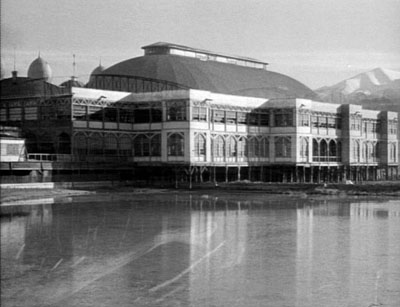
That's the wreckage of the main pavilion. Here's its interior:

It would be hard to do a bad job shooting such an evocative location, and the scenes at Saltair are the best in the film. And I think there's something about using an actual abandoned resort that gives this section moments of creepiness that a more calculated film wouldn't have had. For instance, imagine how you would create a deserted carnival for a horror film (or play a few hours of Carnevil). Then ask yourself if you would have included anything as sad as a long-abandoned Barrel of Fun:
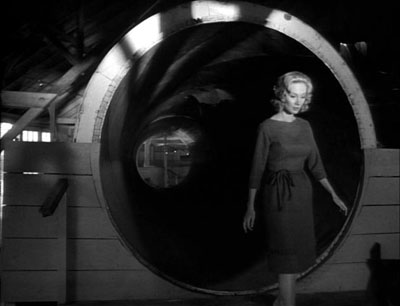
Or as uncanny as the bad advertising art on the wall here (the sign is for Salt Water BATHING, but the woman's face seems to be an advertisement for Inter Family BREEDING):
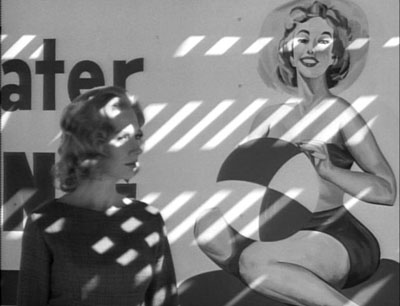
No set designer could come up with anything as weird, sad, creepy, and appropriate as Harvey and his crew found in the wreckage of Saltair. I admit it. I'm a sucker for abandoned places, and I would have been perfectly happy with two hours of footage of what was left of Saltair. The film offers other pleasures as well, however, most notably Sidney Berger's performance as Hilligoss's lecherous neighbor:
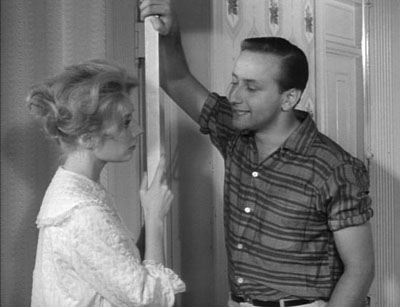
His character is a type of person you don't see too much of in film. He's fiercely anti-intellectual, but in kind of a charming way, starts his day off with whiskey in his coffee, and comes on to Mary Henry full speed ahead from the moment he sees her. In fact, his pursuit of Mary Henry is the focus of the middle third of the film, which is kind of strange because it isn't supernatural in the least. In the horror movies I'm used to seeing, by the end of the first act most subplots are subordinated to whatever the main horror of the film is, but this one doesn't intersect with Mary's other problems at all until the end of the second act. It's a strange choice, but actually, the scenes between Berger and Hilligoss are some of the best written and fastest moving in the movie.
The Criterion edition features two cuts of the movie; the original theatrical release (which features some cuts in the final third) and the original version. In both cuts, a lot more could have been sliced without being missed. There's a recurring scene where Mary Henry becomes invisible to those around her: it's very well done the first time. But the second time it drags on to the point of parody. One of the moments of sheer pulse-pounding terror, for instance, is that she is unable to hail a cab:
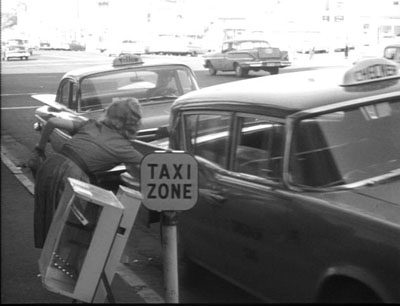
And she has even worse problems at the bus station. Needless to say, transportation problems aren't the stuff of nightmares. But despite all the goofiness towards the end, Carnival of Souls has some moments of inspiration that transcend its Z-movie roots. Even Herk Harvey in greasepaint has one moment of being truly horrifying, rising silently from the salt lake towards the camera.
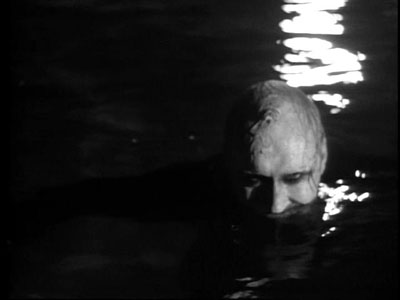
Randoms:
- If that last shot of Harvey looks familiar, it should. Francis Ford Coppola stole the shot (and the creepy, lifeless way Harvey rises out of the water) for Apocalypse Now. Carnival of Souls may be more famous for the later, better films that stole from it than it is great in its own right. George A. Romero has admitted modeling his zombies in Night of the Living Dead on Harvey and the other ghosts in this film. And although there's no direct link, I can't help but think that the Overlook Hotel in The Shining has a little bit of Saltair about it; look again at the picture of dancers in the main ballroom in the place's heyday. Whether or not Stephen King was familiar with the movie, I have no doubt that Kubrick was, because there's a scare shot that's identical to one he used in The Shining. Mary is in her room with John Linden; he leans close behind her and kisses her neck:
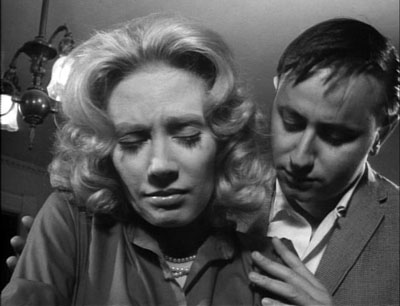
- When she looks up at their reflection in the mirror, however, she finds Herk Harvey's character leering back at her.
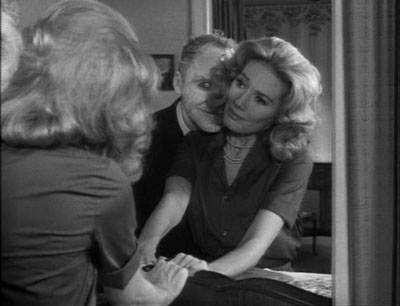
- The idea is better executed in The Shining, but there's no mistaking its origins. It's a strange kind of cinematic glory, to be a well that many more gifted filmmakers have drawn from, but it's better than nothing.
- Harvey and cinematographer Maurice Prather had a great eye for mathematically precise compositions. You can see it in that great shot of Mary at the organ above, and in the following stills, all with very strong diagonal layouts. Notice how precisely the building's shadow defines the frame below:
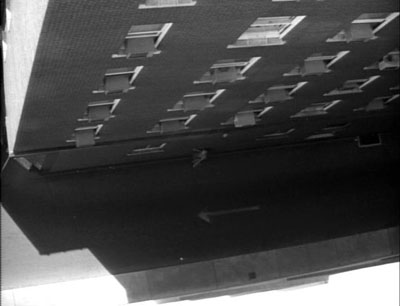
- Of course, organs are naturally pretty mathematically precise:

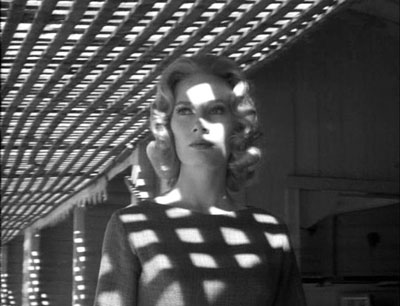
- This last one is symmetric, not diagonal, but is probably my favorite shot in the film; it's from inside the dance pavilion looking out on the salt flats:
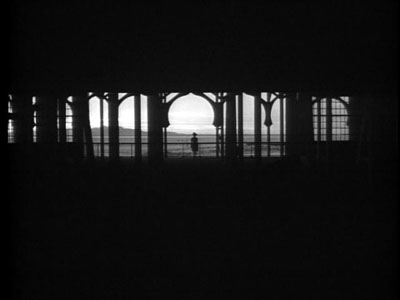
- Virtually the entire crew had a long career at Centron both before and after Carnival of Souls. The DVD includes a lengthy section of excerpts from Centron films. Here's a younger Herk Harvey in one of them, Star 34.

- Star 34 is about a couple from some unnamed large city who inherit a significant amount of money from a distant relative, provided they tour the state of Kansas and learn about its many attractions. Guess which snobbish-at-the-beginning-of-the-film couple fall in love with Kansas? But despite having a clip from Signals: Read 'Em Or Weep, the DVD unaccountably omits Shake Hands With Danger, Herk Harvey's closest thing to a Sid Davis movie, in which construction workers meet disaster after disaster by ignoring workplace safety. Here's a sample:
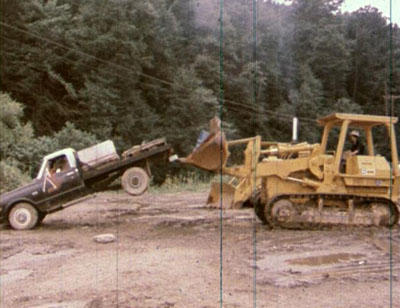
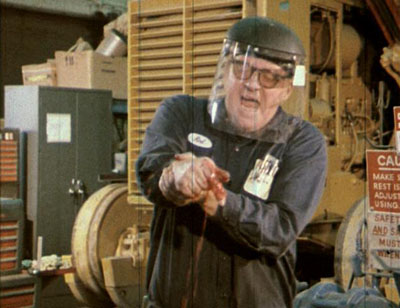
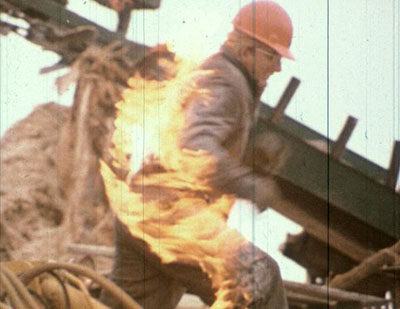

- What really makes the film, though, is its bizarre soundtrack, by a Johnny Cash sound-alike. Sample lyric:
- As easy as it is to snicker at educational and industrial films (and not just easy, but fun), it bears remembering that they were big business in their day. The best, and as far as I know only, source of information about them is Ken Smith's excellent Mental Hygiene: Classroom Films 1945–1970. I can't recommend this book enough. Other invaluable resources are Skip Eisheimer's Educational Archives series of DVDs (the source of the Shake Hands With Danger stills above) and the Prelinger Archives.
- I can't think of another film that was inspired by a single location the way Carnival of Souls was, but I can think of some locations that should have inspired films. My pick would be Heritage USA, the remains of Jim Bakker's criminal empire. Check out the "Take a Tour of Heritage" to get a feel for the place. You could do a lot of interesting things shooting in the Grand Tower. If anyone else has great location ideas, leave them in the comments.
Shake hands with danger
Meet a guy who oughta know
I used to laugh at safety,
Now they call me... Three-Finger Joe.


27 comments:
Awwww right, another post. Thanks a pile -- I've been using your very very well written posts as a guide on what to pick up from Netflix. Wages of Fear is one of the best movies I've seen in the past few years.
Now how long 'til the next one?
John,
Not as long. My goal in the new year is to get back to one per week if it kills me. Glad you liked Wages of Fear, it was one of my favorites.
Matt
Oh, and hey, I'm glad you namechecked the Prelinger archives. As both a librarian and MST3K fan, the Prelinger collection is sweet, sweet candy to me. Shake Hands with Danger can be downloaded from here, along with piles of other Centron goodies.
Hey there, great site! I really enjoy reading your reviews.
I will admit to a deep and abiding appreciation of carnival of souls. okay, maybe not deep or abiding, but it's a big guilty pleasure at times for me. The Saltair footage is great.
Have you heard of Handcranked Film? Two of the directors from that collective have made a short film called "Met State" (that's available in the Lumen Eclipse gallery -- I'm on a computer that will not allow me to view the galleries, alas), and are expanding that into a feature called American Ruins.
--Chelsea
John,
Thanks for the link to "Shake Hands With Danger." Well worth a look for anyone who hasn't seen it. I understand Mike Nelson does a commentary track on one of the DVDs of Carnival of Souls, have you seen it? I was a big MST3K fan back in the days of VHS but haven't seen it in a long time.
Anonymous,
I haven't heard of Handcranked Films but American Ruins looks like something I'm going to love. I'll be downloading Met State as soon as I get a chance. So thanks for the tip!
Matt
How about a shout-out to Bergman or Antonioni, two other influences on the movie?
are there any other similarities to Carnevil?
Jeff,
I don't know Bergman or Antonioni well enough to say anything intelligent about their influence here. John Clifford said they were going for "the look of a Bergman and the feel of a Cocteau," but I don't know where Antonioni comes into it. But yes, a shoutout is probably deserved, so: Holla! If there are specific links, influences, &c. that you know of by all means elaborate.
Anonymous,
You're talking to one of the few people on the planet who's played all the way through Carnevil, in an arcade on the French Quarter one very drunken New Year's (1998–1999). It was one of those things that seemed like a good idea at the time. So although I can't comment on Antonioni, I can say with nearly 100% certainty that there are no similarities to Carnevil. Wikipedia says one inspired the other, but I think that's crazy talk. You could make a pretty great movie about the further adventures of Ludwig Von Tokkentakker, though.
Matt
Its nice to have this site back up and running.
My suggestion for interesting locations is the town of Uranium City, Saskatchewan, Canada. Its a ghost town in northern Canada. It used to house 5,000 people; now only 70 people live there. It is said that you can buy houses for a dollar, and that on people's birthdays they will often end up owning entire blocks. Its a creepy place.
Matt,
Loved your take on Carnival of Souls -- I watched it a few months ago and was very pleasantly surprised -- I don't always go for the "b horror," but found it to be a very visually striking and moody film.
Also thanks for the link to the Prelinger Archives -- I had forgotten that they existed. I first heard about them in college; my documentary professor knew Rick Prelinger and told us how he had collected these old films from garbage over the years and had put them online. It's good stuff, I'm glad it's still out there.
Matthew,
Uranium City sounds like a great place to shoot the kind of movie that involves burning down or blowing up houses.
Jim, yeah, it's a notch above B horror. And Prelinger does good work, it's kind of crazy to think we're losing so many of those films forever.
I like your take on Carnival Of Souls. I'm a bigger fan than you, but I'll admit that it isn't as good as I'd like it to be.
If you educational or industrial films, I'd like to suggest a documentary called Hell's Highway. It's specifically for driver's ed films from the 1950s and 1960s. It's not quite as detailed as I would have liked, but there is some interesting behind the camera kind of stuff involved.
"Session 9" would be another example of a movie directly inspired by a location...an abandoned mental hospital, to be exact. As you say, you'd have to work pretty hard to make a hash out of trying to scare people with a location like that.
the dave,
I have kind of a morbid fear of photos of actual dead people, so I've been trying not to watch Driver's Ed films. But I've always been a little curious about the rumors about the Highway Safety Foundation, so maybe I'll have to check that out.
yves perret,
Yeah, I wanted to see Session 9 when it came out. Since I wrote this, my sister toured a great location in St. Louis: a children's asylum. I'm not making that up. Turn of the century, huge, only a small part of the building was still in use. Hallways of little dorm rooms for disturbed kids that locked on the outside. Wish I had a horror script and lived in St. Louis...
Matthew,
I joined your quest to watch the entire criterion collection at the Night Porter (as I notified you by private email). After getting way ahead of you, I'm now falling behind and have just seen Carnival of Souls.
While I wasn't completely awed by this movie, I can see why it's a cult favorite and why other people might fall in love with it. I was amazed by some of the cinematography and loved the soundtrack. On the other hand and as you note, it can be a bit cheesy at times; that may add to its charm for some viewers, but I thought it was just a bit silly.
After devouring the entire Criterion version of this movie, I'm losing my desire to see every special feature on a title. Do I really need to hear the same stories repeated in the documentary, the audio commentary, and in the text interviews? I might uncover a nugget or two extra of information by doing so, but it seems awfully inefficient. Are you getting impatient with all of the special features as well? While they may be interesting, I think my time might be better spent seeing more movies (or reading more books).
Mark,
Yeah, sometimes there's a lot of duplicate information on the extras, especially on the Carnival of Souls 2-disk spectacular. What I find more frustrating, however, is the lack of special features on the more difficult films (e.g., Salò or The Blood of a Poet), where I really would like to hear someone making a detailed case for the film's greatness. Not that I want to watch Salò again, mind you...
Glad to hear you're back to watching these.
I lived next to Met State (the old mental hospital, not the film!) for years, and even worked on a horror film that was shot there (the same time Session 9 was shooting up at the abandoned Danvers State Hospital, amazingly enough The horror film was never released, by the way.). It was amazing to walk around it, this immense, crumbling, Angkor Wat like state mental hospital, and find things downstairs like boxes of old patient files ("No longer lights fires on the ward.")
I also know the guys who made Met State, and it's a great film--it captures the erieness and sadness of old ruins like that a lot better then Session 9 did. Everyone should check it out.
Massachusetts seemed to rife with abandoned state mental hospitals for a while, but now most of them have been renovated. Met State, for instance, is no longer the derelict structure you see in the short film: they knocked down the buildings that had been built in the 70s and 80s and turned the big main buildings into apartments. I wish they'd just left it the way it was, but, it also attracted vandals and criminals when it was empty. And it was a place of suffering when it was open: few walls probably had soaked up more screams, and as an abandoned building it truly did feel like it was full of ghosts, and not happy ones, either.
Oh, and Matt, that St. Louis hospital your sister visited? Well, right next to Met State was their equivalent. And that's still there, still abandoned, and very much like the one you described...
And right up the road is the Fernald School, which was exclusively a hospital for disturbed children, and which was where they did the radiation experiments on the kids in the 50s...and which is still open...
JJ,
So what are you doing posting comments on a blog, man? You should be making a horror movie! One of the downsides to Los Angeles is there's not much tragic history.
Carnival of Souls is currently being converted to 3D.....
http://www.youtube.com/watch?v=UrcsE4itGE0&feature=player_embedded
Currently converting Carnival of Souls into 3D using depth maps. See my blog and YouTube clips for further info.
I only wish I could have used the Criterion transfer instead of the public domain version...oh well...maybe one day.
I've seen the Mike Nelson commentary for Carnival of Souls, though not the later three man Rifftrax version. I was rather disappointed, it wasn't his strongest and he wasn't acknowledging that the movie is above the normal horrid MST3k crap (it bothers me how little interested in movies Nelson actually is sometimes.)
I always look at this movie as an extra long Twilight Zone episode- the acting is a little flat sometimes, but the premise is solid, and the cinematography is unbelievable for something shot by people who weren't normally paid for artistry. I actually really liked both 'everything goes silent' sequences- along with the organ music, the soundtrack of the movie has an eerieness that doesn't have many equals.
It's funny to hear of someone thinking Sidney Berger's character as charming, though- he set off way, way too many date rapist bells for me to find him anything but creepy.
Also, there are a lot of great collections of educational shorts put out by the BFI- my personal favorite is the sex education one (http://www.amazon.co.uk/Birds-Bees-DVD-Various/dp/B004IY7KWU/ref=sr_1_2?s=dvd&ie=UTF8&qid=1300765187&sr=1-2) but there are a lot of them. They don't come with anything like the kind of scholarly context I'd like to see, but they're still great and very worth importing.
Tom,
Let's say his anti-intellectualism is charming. Re the BFI stuff, I have six volumes of "The Educational Archives" set, which is enough for me (favorite? "Lunchroom Manners," with Mr. Bungle). Are British educational films their own thing?
Well, in that there's a distinct Englishness to them, certainly- the Sex Ed ones are interesting in part because they're all over the place in terms of format, from little fictional pieces to cartoons to harrowingly explicit true stories in the 70s. They're sort of the sex equivalent of the terrifying Driver's Ed or work safety film.
Great locations? Since you like abandoned places, check out all the dead them parks in Japan. The Japanese mistakend thought that they'd be able to pull in Chinese from the mainland.
I totally love 'Carnival Of Souls" take it seriously, and think the set is probably the most fun of any in the Criterion Collection. I don't think Candice Hilligoss has ever been given fair credit for her amazing, rather brave performance. I also like the guy in the roadhouse scene (Steve Boozer as Chip) who wonders into movie history, says something sleazy, and wonders out. In all seriousness, some of the photography is really great.
Post a Comment